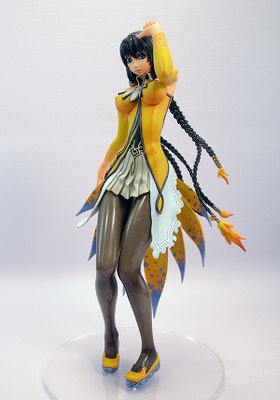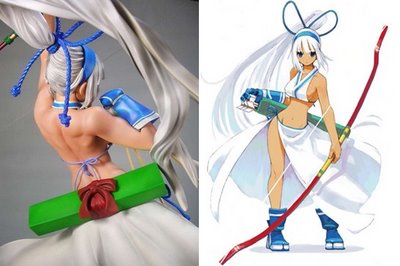

 from Nitro+ eroge game called Jingai Makyo: Chaos Gate. Igunis is a Japanese elf intent on ridding the world of tentacled monsters.
from Nitro+ eroge game called Jingai Makyo: Chaos Gate. Igunis is a Japanese elf intent on ridding the world of tentacled monsters.Igunis Figure from Max factory
tags igunis ignis jingai makyo chaos gate wallpaper


 from Nitro+ eroge game called Jingai Makyo: Chaos Gate. Igunis is a Japanese elf intent on ridding the world of tentacled monsters.
from Nitro+ eroge game called Jingai Makyo: Chaos Gate. Igunis is a Japanese elf intent on ridding the world of tentacled monsters.

 Character from Ps2 game Magna Carta, 1/6th scale figure from Cerberus Project comes prepainted with minor assembly required.
Character from Ps2 game Magna Carta, 1/6th scale figure from Cerberus Project comes prepainted with minor assembly required. The second edition of one of Japan's longest running manga series is now back in print in an English-language edition, reformatted to match the current 3x3 Eyes titles. Yakumo is an ordinary Tokyo high-school student who is helping a not-so-ordinary 300-year-old girl from Tibet named Pai on a quest to discover a way for Pai to become human, a quest that exposes Yakumo to the terrors best kept in nightmares. But when Yakumo returns to Japan thinking he can resume his old life, he discovers that the evils of hell have come with him! creator Yuzo Takada (Black and white. 160 pages.)
The second edition of one of Japan's longest running manga series is now back in print in an English-language edition, reformatted to match the current 3x3 Eyes titles. Yakumo is an ordinary Tokyo high-school student who is helping a not-so-ordinary 300-year-old girl from Tibet named Pai on a quest to discover a way for Pai to become human, a quest that exposes Yakumo to the terrors best kept in nightmares. But when Yakumo returns to Japan thinking he can resume his old life, he discovers that the evils of hell have come with him! creator Yuzo Takada (Black and white. 160 pages.)

 Masamune Shirow (Masanori Ota)is one of the most famous anime and manga creators in the world. He is best known for the manga Ghost in the Shell, which has since been turned into two anime movies, two anime TV series and several video games. Many of his works (Ghost in the Shell, Dominion: Tank Police, Appleseed) follow the theme of a strong apparently independent female law enforcer tackling evil, in a near-future setting with strong cyberpunk influences, while facing difficulties from internal politics.
Masamune Shirow (Masanori Ota)is one of the most famous anime and manga creators in the world. He is best known for the manga Ghost in the Shell, which has since been turned into two anime movies, two anime TV series and several video games. Many of his works (Ghost in the Shell, Dominion: Tank Police, Appleseed) follow the theme of a strong apparently independent female law enforcer tackling evil, in a near-future setting with strong cyberpunk influences, while facing difficulties from internal politics.

 Prepainted, assembly required (according to Hobbyfan) though Hobbylink suggest otherwise, Check with retailer before purchase.
Prepainted, assembly required (according to Hobbyfan) though Hobbylink suggest otherwise, Check with retailer before purchase.

 Standing 22cm tall, prepainted pvc figure Kasumi a character from Dead or Alive Game series by Tecmo, also known as "the Kunoichi of Destiny".
Standing 22cm tall, prepainted pvc figure Kasumi a character from Dead or Alive Game series by Tecmo, also known as "the Kunoichi of Destiny".

 This Ps2 RPG was originally released in Korea, where it was subtitled Crimson Stigmata. Reith or Rith is a young girl who suffers from amnesia. She finds the central character Calintz badly hurt and treats his wounds. She possesses a unique divine power, and her lost memories contain an interesting story. Her fighting style is "Kyusei," a style with strong healing and restorative properties.
This Ps2 RPG was originally released in Korea, where it was subtitled Crimson Stigmata. Reith or Rith is a young girl who suffers from amnesia. She finds the central character Calintz badly hurt and treats his wounds. She possesses a unique divine power, and her lost memories contain an interesting story. Her fighting style is "Kyusei," a style with strong healing and restorative properties.
 Character from hit Anime series, Manga and Movie, Nana.
Character from hit Anime series, Manga and Movie, Nana.

 1/6th scale Garage Kit from Cerberus project Assembly and painting required. See Garage Kits
1/6th scale Garage Kit from Cerberus project Assembly and painting required. See Garage Kits
 Garage kits are essentially pre-moulded model kits, which have to be assembled, glued and then painted. The term originated with dedicated hobbyists frustrated with having being unable to find model kits of subjects they wanted on the market and so started producing kits of their own. As the processes of sculpting, casting and painting produce dust and fumes, most of the sculptors used their garages as their workshops, hence the name.
Garage kits are essentially pre-moulded model kits, which have to be assembled, glued and then painted. The term originated with dedicated hobbyists frustrated with having being unable to find model kits of subjects they wanted on the market and so started producing kits of their own. As the processes of sculpting, casting and painting produce dust and fumes, most of the sculptors used their garages as their workshops, hence the name.


 Character from Black Lagoon
Character from Black Lagoon Written by Masamune Shirow, the author/artist of the cyberpunk cult-classic Ghost in the Shell, Masamune Shirow. This is volume one of a shonen manga that inspired both a 1988 and a 2004 Japanese animated film.
Written by Masamune Shirow, the author/artist of the cyberpunk cult-classic Ghost in the Shell, Masamune Shirow. This is volume one of a shonen manga that inspired both a 1988 and a 2004 Japanese animated film.